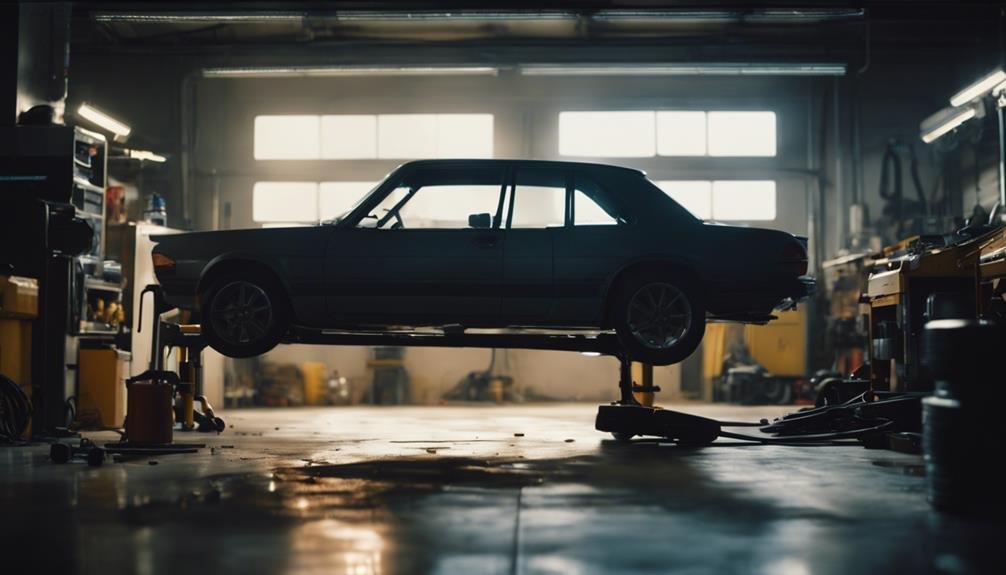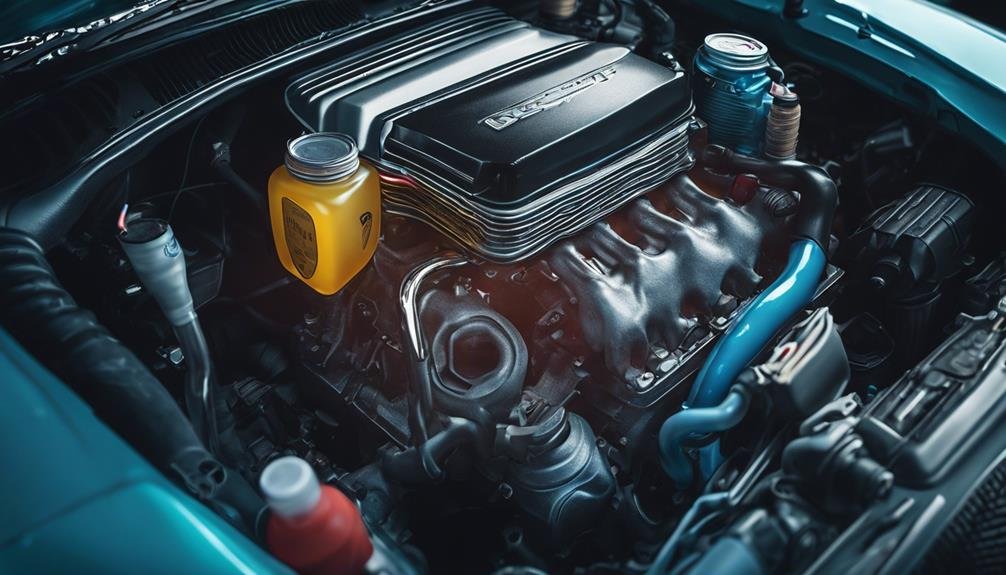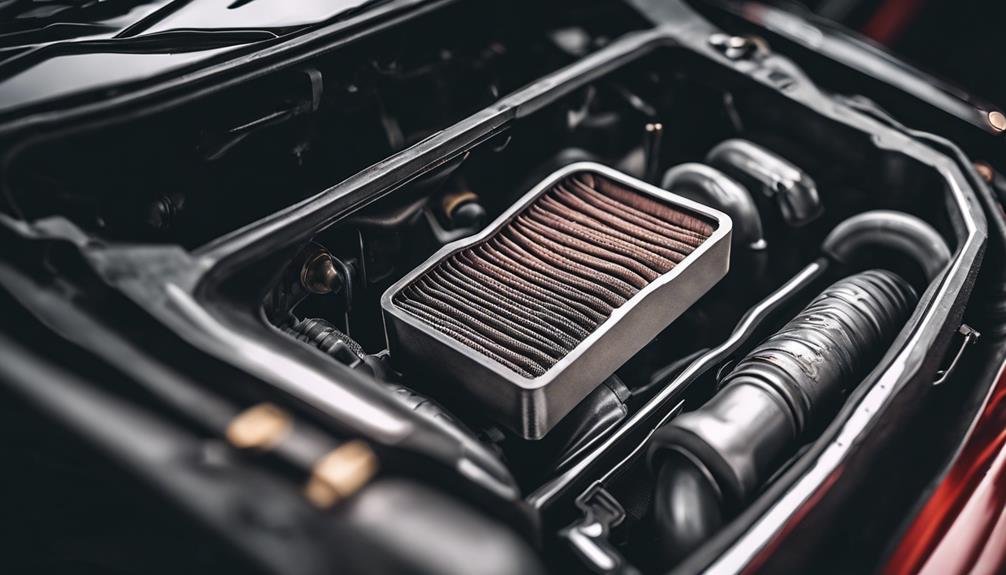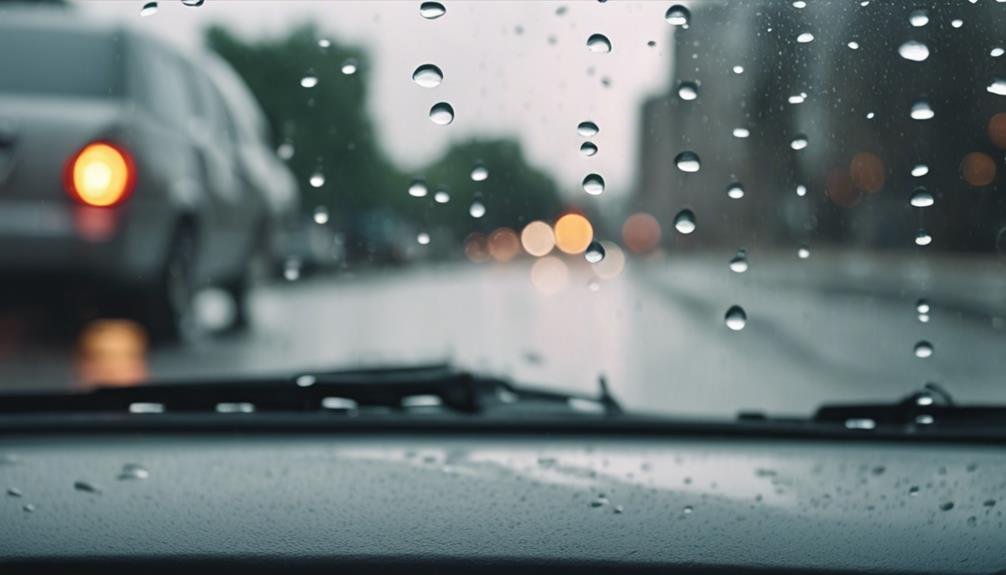As you lift the hood of your car, you'll find important components like the engine, transmission, and cooling systems, which work together to keep your vehicle running smoothly. The oil system lubricates the engine, while the power steering pump facilitates smooth steering, and the alternator and battery generate power for electrical systems. Regular inspections of belts, hoses, and fluids are vital for peak performance. By understanding these systems, you'll be better equipped to diagnose issues and maintain your car's overall health. Take a closer look, and you'll learn more about what makes your car tick.
Key Takeaways
- The engine is the heart of the car, relying on the oil system for lubrication and the alternator for power generation.
- Regular inspection of belts, hoses, and fluids is crucial for optimal performance and preventing breakdowns.
- The transmission and cooling systems work together to regulate engine temperature and facilitate smooth gear shifting.
- Battery maintenance is essential, involving checks on connections, acid leaks, and fluid levels to prevent unexpected breakdowns.
- Regular checks on lights, wiper blades, and washer fluid ensure clear visibility and a safer driving experience.
Engine Basics and Components
As the heart of your vehicle, the engine plays a significant role in powering your car's movement, and understanding its components is important for peak performance and longevity.
The engine size and configuration may vary depending on your vehicle model, but its components remain crucial for top functioning. One such critical component is the oil system, which lubricates the engine, reducing friction and preventing overheating. Regularly checking oil levels is crucial, as low levels can cause severe engine damage.
Another important component is the Power Steering Pump, responsible for facilitating smooth steering. Furthermore, the alternator and battery work together to generate and store power for your vehicle's electrical systems.
To make sure your engine runs smoothly, it's vital to regularly inspect belts, hoses, and fluids, including coolant levels, to prevent overheating and damage.
Transmission and Cooling Systems
You depend on your transmission to shift gears smoothly and transfer power to the wheels, making it a critical component of your vehicle's complete performance. Located beneath other engine parts, the transmission plays a pivotal role in guaranteeing your car runs efficiently. For automatic transmissions, you can check the fluid level using a visible red dipstick, making regular maintenance a breeze.
The cooling system, comprising the radiator and fan, is equally important, as it regulates engine temperature to prevent overheating and ensure peak performance. A well-functioning cooling system is crucial to prevent costly repairs and maintain overall car functionality. Understanding how these systems work is key to diagnosing issues and ensuring proper care of these critical components.
Regular maintenance of the transmission and cooling systems is vital to prevent breakdowns and maintain your car's overall health. By staying on top of maintenance, you can avoid costly repairs and ensure your vehicle runs smoothly for years to come.
Battery Maintenance Essentials

Your car's battery plays a crucial role in powering essential systems, including the engine, and regular maintenance is significant to prevent unexpected breakdowns.
As the battery supplies electric power to different vehicle systems, including starting the engine, monitoring its health is vital for preventing starting issues and maintaining electrical systems.
To make sure of proper functioning, you should regularly check the battery connections for cleanliness and tightness. Corrosion or loose connections can hinder the battery's performance, leading to problems down the line.
Moreover, be mindful of battery acid leaks, which can occur due to use and heat. If you notice any leaks, use specialized cleaners to clean the area.
Remember, different car makes have varying battery locations within the engine compartment, so consult your owner's manual to find yours.
Belts, Hoses, and Pulleys Check
Properly functioning belts, hoses, and pulleys are pivotal to your car's operation, driving significant engine components and transporting necessary fluids throughout the engine compartment.
As you pop the hood, it's imperative to check these critical components regularly to prevent breakdowns and costly repairs. Start by inspecting your belts, such as the serpentine belt, which drives essential engine components like the alternator and water pump. Look for signs of wear like cracks, fraying, or leaks, which indicate the need for immediate replacement.
Next, examine your hoses, which transport coolant, air, and other fluids throughout the engine compartment. Check for signs of damage, brittleness, or leaks, and replace them if necessary.
Don't forget to inspect your pulleys, which guide your belts and provide mechanical advantage for engine components. A regular check of these components can help you identify potential issues early on, saving you time and money in the long run.
Fluids and Reservoirs Overview

As you open the hood, a duo of reservoirs catches your attention, holding important fluids that keep your car running smoothly and safely on the road. These reservoirs are responsible for maintaining ideal fluid levels, which are vital for the proper functioning of your vehicle.
Here are some key points to keep in mind when dealing with fluids and reservoirs:
- Windshield Wiper Fluid Reservoir: Holds the fluid that keeps your windshield clean and clear, ensuring unobstructed visibility while driving.
- Coolant Overflow: Regulates engine temperature, preventing overheating and potential damage to your engine.
- Fluid Levels: Regularly checking and maintaining proper fluid levels in the reservoirs is crucial for excellent performance and safety.
- Reservoir Maintenance: Monitoring and refilling the reservoirs, like the coolant and wiper fluid reservoirs, are critical steps in ensuring the proper operation of essential car systems.
Brake Pads and Rotor Inspection
You're now checking the brake pads and rotors, critical components that require regular inspection to guarantee your safety on the road.
Brake pads, in particular, should be at least 3mm thick for best performance and safety. If they're worn down, you'll likely hear squeaking or grinding noises when braking, indicating it's time for a replacement. Inspecting your brake pads regularly can prevent costly repairs and ensure braking efficiency.
When inspecting your rotors, check for wear and warping, as uneven rotor thickness can affect your car's braking efficiency. If you notice any irregularities, consider consulting a professional for assistance.
While DIY brake pad and rotor replacement is possible with the right tools and instructions, it's recommended that beginners seek professional help to avoid any mistakes. By staying on top of brake pad and rotor inspection, you'll be safeguarding your safety on the road and avoiding potential problems down the line.
Regular checks will give you peace of mind and help you avoid costly repairs, so make it a habit to prioritize this critical maintenance task.
Air Filter and Intake System

Your car's air filter and intake system play a vital role in delivering clean air to the engine, ensuring peak performance and longevity. The air filter system is responsible for providing the engine with the oxygen it needs to run efficiently, and any disruptions can negatively impact engine performance.
Here are some key things to keep in mind about your air filter and intake system:
- Important airflow is crucial: The air filter housing and intake tube ensure clean air reaches the engine, and any blockages can decrease engine performance.
- Check for vacuum leaks: In older vehicles, check connections for potential vacuum leaks that can affect engine performance.
- Upgrade for better airflow: Aftermarket intake systems can boost airflow and horsepower output in certain vehicle models.
- Regular maintenance is key: Regularly changing the air filter is vital to maintaining a healthy intake system and engine function.
Headlight and Taillight Maintenance
Proper headlight and taillight maintenance is vital for safe driving, and regular inspections can help prevent accidents and guarantee compliance with road safety regulations.
You should regularly inspect and replace headlight and taillight bulbs to ensure ideal visibility on the road. When replacing bulbs, use appropriate tools and techniques to safely change them, and ensure proper alignment and secure installation to prevent malfunctions. Moreover, clean your headlight lenses to improve light output and visibility while driving.
Regularly check your headlight and taillight functionality to adhere to road safety regulations. It's essential to check your headlights and taillights regularly to ensure they're functioning correctly, as faulty lights can significantly reduce your visibility on the road. By maintaining your headlights and taillights, you can decrease the risk of accidents and ensure a safer driving experience.
Wiper Blades and Washer Fluid Check

As you drive, streaks on your windshield or skipping wiper blades signal it's time to replace them, ensuring clear visibility on the road. Properly functioning wiper blades and an adequate washer fluid supply are crucial for safe driving in different weather conditions.
Here are some key points to keep in mind when checking your wiper blades and washer fluid:
- Replace wiper blades when you notice streaks or skipping on your windshield to maintain clear visibility.
- Check the washer fluid reservoir regularly and refill with windshield washer fluid as needed.
- Perform a visual check of your wiper blades for signs of wear, such as cracks or worn rubber.
- Monitor the fluid reservoir level without opening it, as it's usually transparent, and refill as needed.
Frequently Asked Questions
What to Look for When Buying a Car Under the Hood?
When buying a car, you'll want to check under the hood for signs of regular maintenance, like clean oil and proper fluid levels, and inspect vital components like the battery, radiator, and transmission for good working order.
What Is Underneath the Hood of a Car?
You'll find the engine, transmission, radiator, and other crucial components underneath the hood of your car, all working together to keep you safe and on the road, and it's important you know what they do.
How Do You Detail Under the Hood of a Car?
You'll start by disconnecting the battery and covering sensitive parts, then use a degreaser to remove grime, scrubbing hard-to-reach areas with a brush and rinsing thoroughly, before drying and applying a protective dressing.
How Do You Package a Hood?
When packaging a hood, you'll want to secure it properly to prevent damage during transit, using padding or bubble wrap to shield the surface, and sturdy materials to keep it in place.
What Are the Things That Stick Out of the Hood of a Car?
When you pop the hood, you'll notice a few things sticking out – don't worry, they're vital! You'll spot the radiator cap, oil fill cap, and windshield washer fluid cap, all playing important roles in keeping your ride running smoothly.
Conclusion
Now that you've lifted the hood, you've gained a deeper understanding of your vehicle's crucial components.
You've learned about engine basics, transmission, and cooling systems, along with the significance of battery maintenance, belts, hoses, and pulleys.
You've also inspected fluids, reservoirs, brake pads, rotors, air filters, intake systems, headlights, taillights, wiper blades, and washer fluid.
With this knowledge, you're better equipped to identify potential issues, perform routine maintenance, and guarantee your vehicle runs smoothly and efficiently.
